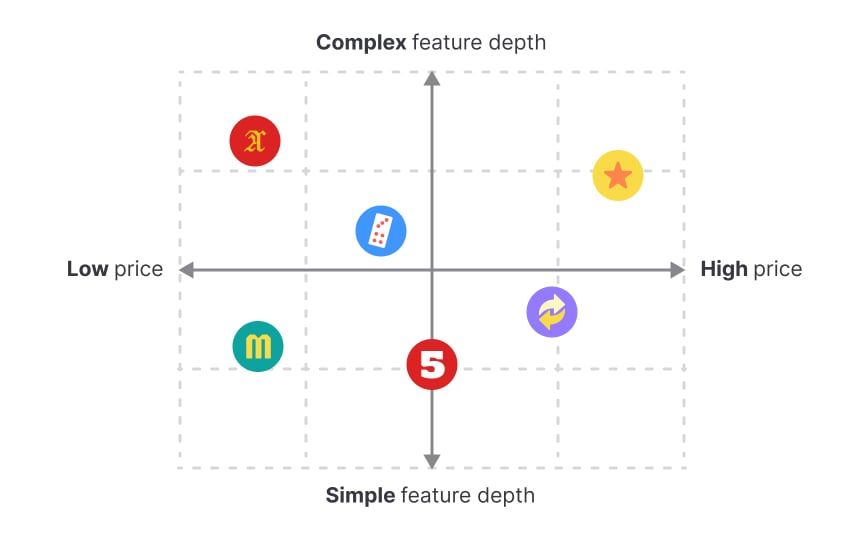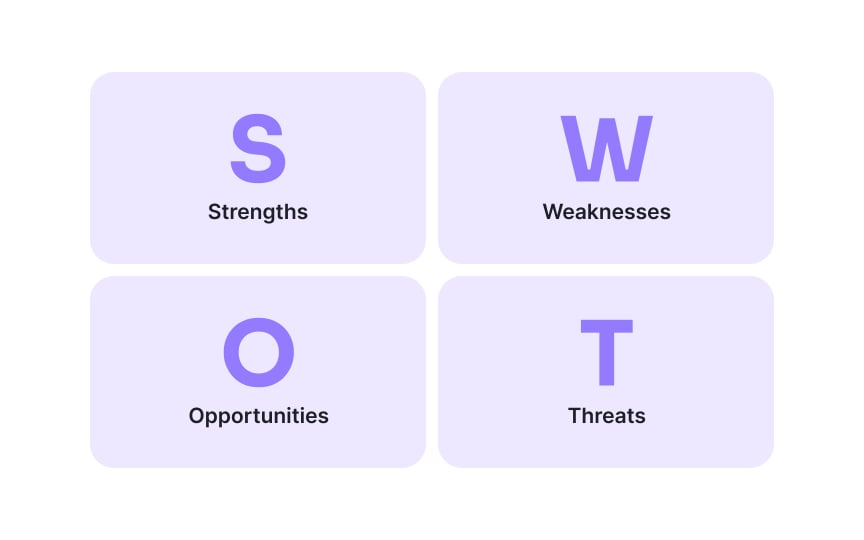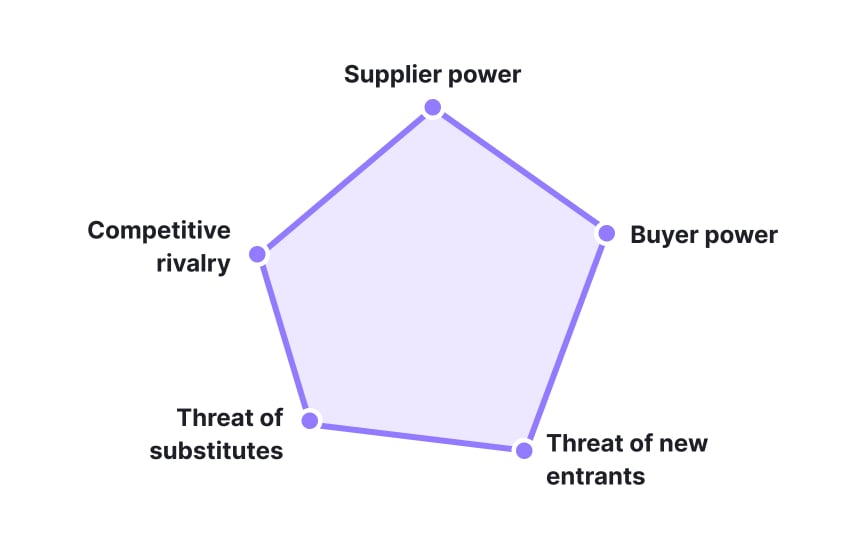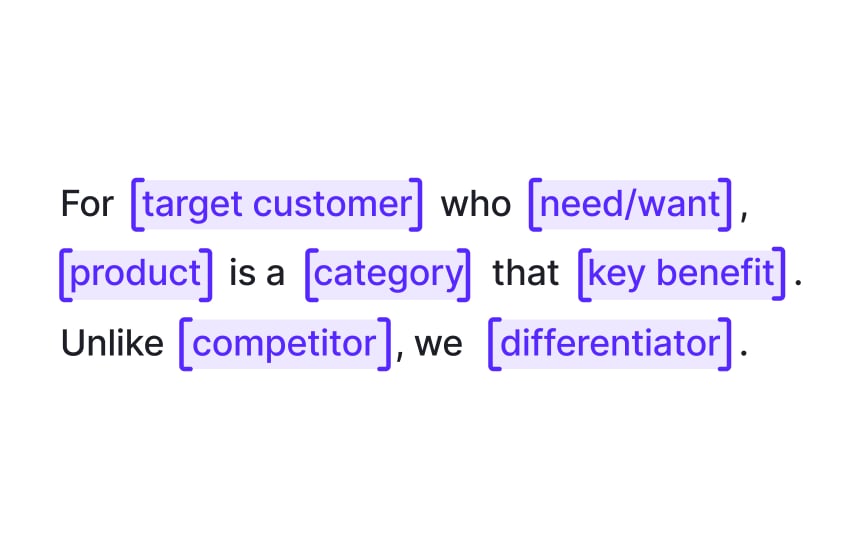Market Analysis & Competition
Analyze markets and competitors systematically to spot opportunities and make smarter product decisions
Market analysis helps product managers spot opportunities before competitors do. It starts with understanding who your customers are, what problems they face, and how much they're willing to pay for solutions. You'll examine industry trends, calculate market sizes, and identify which segments offer the most potential. Competitive analysis goes beyond listing features. It's about understanding why customers choose certain products, where competitors fall short, and what gaps exist in the market. This knowledge shapes everything from pricing strategies to feature priorities.
Smart PMs use frameworks like SWOT analysis and Porter's Five Forces to organize their findings and spot patterns others miss. They track competitor moves, monitor customer feedback, and watch for market shifts that could disrupt the status quo. Regular market assessment keeps your product strategy fresh and responsive. The insights you gather directly impact your roadmap, helping you decide which features to build, which markets to enter, and how to position your product for success.
Market sizing determines how many potential customers exist for your product and how much they might spend. TAM (Total Addressable Market) represents the maximum revenue opportunity if you captured 100% of the market. This metric helps validate whether an opportunity is worth pursuing.
Start with a top-down approach: find industry reports showing total market value, then estimate your potential share. Bottom-up calculations work differently - multiply the number of potential customers by average revenue per user. Both methods should arrive at similar figures.
Most products target a subset of TAM called SAM (Serviceable Addressable Market), which considers geographic and regulatory constraints. Your SOM (Serviceable Obtainable Market) is the realistic portion you can capture given competition and resources.[1] These calculations guide investment decisions and growth projections.
Customer segmentation divides your market into distinct groups with similar characteristics, needs, and behaviors. Effective segmentation helps you tailor products, messaging, and pricing to specific audiences.
Common segmentation methods include demographic, geographic, psychographic, and behavioral criteria:
- Demographics cover age, income, and education level
- Behavioral segmentation examines purchase patterns, usage frequency, and brand loyalty
- Psychographic factors include lifestyle, values, and attitudes.
B2B segments often focus on company size, industry, and decision-making processes. Good segments are measurable, accessible, substantial, and actionable. Each segment should be different enough to warrant unique strategies but large enough to justify the effort. Regular analysis reveals shifting segment needs and emerging opportunities.
Pro Tip: Start with 3-5 distinct segments. Too many makes execution impossible, too few misses opportunities.
Competitive landscape mapping visualizes where competitors position themselves in the market. This exercise reveals market gaps, overcrowded segments, and differentiation opportunities.
Common frameworks include:
- Perceptual maps plot competitors on two key dimensions customers care about, like
price vs. quality or simplicity vs. power - Feature matrices compare specific capabilities across competitors
- Market share analysis shows relative strength and momentum of different players.
Keep in mind that direct competitors offer similar solutions to the same customers. Indirect competitors solve the same problem differently. Potential competitors might enter from adjacent markets. Understanding all 3 types helps anticipate market dynamics and strategic moves.
SWOT analysis examines internal Strengths and Weaknesses alongside external Opportunities and Threats. This framework provides a structured way to assess your competitive position and strategic options.
Each quadrant reveals different insights about your product's market readiness:
- Strengths might include unique technology, strong
brand , or excellent team - Weaknesses could be limited resources, technical debt, or poor market timing
- Opportunities encompass market trends, competitor mistakes, or regulatory changes
- Threats include new entrants, substitute products, or economic downturns
The real value comes from connecting quadrants. Can you use strengths to capture opportunities? How might you address weaknesses before threats materialize? This cross-analysis generates actionable strategies rather than just lists.[2]
Porter's 5 forces is a framework created by Harvard professor Michael Porter in 1979 to analyze industry competition. ****
It examines 5 factors that determine profitability:
- Competitive rivalry measures how intensely existing companies compete
- Supplier power shows whether vendors can dictate terms
- Buyer power indicates if customers can demand lower
prices - Threat of substitutes warns when alternative solutions could replace you
- Threat of new entrants assesses how easily competitors can enter your market[3]
Each force is rated from low to high. Industries where all 5 forces are weak (like software) tend to be highly profitable. Industries with strong forces (like airlines) struggle with thin margins. By understanding these dynamics, you can develop strategies to weaken the forces working against you.
Market trends reveal where industries are heading, helping you build products for tomorrow's needs rather than yesterday's. Effective trend identification combines multiple data sources: industry reports, search trends, social media patterns, and patent filings.
Look for signals that persist across channels:
- Macro trends like remote work or sustainability affect entire industries
- Micro trends impact specific segments or use cases
- Technology trends include emerging platforms or capabilities
- Social trends reflect changing behaviors and values
- Economic trends influence spending patterns and priorities
Distinguish between fads and lasting trends by examining underlying drivers. Real trends solve persistent problems or align with demographic shifts. A useful tool to use is Gartner’s Hype Cycle, which measures hundreds of technologies on 95 standard hype cycles annually.[4] Also track trend velocity (how fast adoption is growing) to time market entry correctly.
Customer needs assessment uses research methods to discover what problems users face and how they currently solve them. Start with user interviews to understand context and motivations. Follow up with surveys to quantify how many people share similar needs. Combine both to build a complete picture.
Good research goes beyond asking "What features do you want?" Instead, explore current workflows, frustrations, and workarounds. Shadow users in their environment to see problems they don't mention. Review support tickets and forum posts for recurring complaints. Analytics data reveals where users struggle or abandon tasks.
The best insights come from identifying gaps between what users say and do. They might request faster horses, but observing their commute reveals they need reliable transportation. Document findings in user personas and journey maps to share insights across teams.
Market opportunity evaluation weighs potential rewards against required investments and risks. This analysis combines market size, growth rate, competition intensity, and your ability to win. Good opportunities balance attractive markets with realistic execution paths.
Evaluate market attractiveness using size, growth, and profitability metrics. Assess competitive dynamics through market concentration and differentiation potential. Judge execution feasibility based on required resources, capabilities, and timing. Score each dimension to compare opportunities objectively.
The best opportunities often hide in market transitions like regulation changes, technology shifts, or business model innovations. These moments reset competitive advantages and create openings for new entrants. Watch for markets where customer satisfaction lags despite high spending.
Positioning strategy defines how customers should perceive your product versus alternatives. Effective positioning claims a distinct place in customers' minds by highlighting unique value. This requires choosing what to emphasize and, equally important, what to sacrifice.
Strong positions connect to specific customer needs and competitive gaps. They're credible, distinctive, and relevant. For example, Amazon owns "selection and speed." Volvo means "safety." Your position should be equally clear and defensible. Test positioning statements with target customers to ensure they resonate.
Positioning influences every customer touchpoint: messaging, features,
References
- Porter's Five Forces Explained and How to Use the Model | Investopedia
























